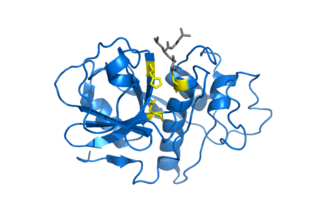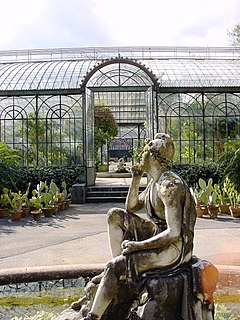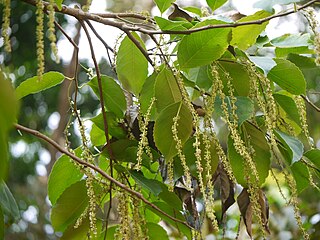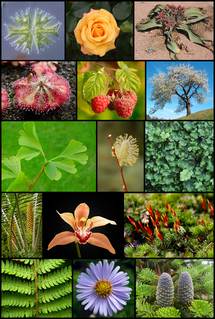
The flowering plants, also known as Angiospermae, or Magnoliophyta, are the most diverse group of land plants, with 64 orders, 416 families, approximately 13,000 known genera and 300,000 known species. Like gymnosperms, angiosperms are seed-producing plants. They are distinguished from gymnosperms by characteristics including flowers, endosperm within their seeds, and the production of fruits that contain the seeds. Etymologically, angiosperm means a plant that produces seeds within an enclosure; in other words, a fruiting plant. The term comes from the Greek words angeion and sperma (seed)

Robert Anthony Plant is an English singer, songwriter and musician, best known as the lead singer and lyricist of the English rock band Led Zeppelin.

A perennial plant or simply perennial is a plant that lives more than two years. The term is often used to differentiate a plant from shorter-lived annuals and biennials. The term is also widely used to distinguish plants with little or no woody growth from trees and shrubs, which are also technically perennials.

Ancylostoma is a genus of nematodes that includes some species of hookworms.

Cysteine proteases, also known as thiol proteases, are enzymes that degrade proteins. These proteases share a common catalytic mechanism that involves a nucleophilic cysteine thiol in a catalytic triad or dyad.

The Orto Botanico di Palermo is both a botanical garden and a research and educational institution of the Department of Botany of the University of Palermo. The garden lies within the city of Palermo, Italy at 10 m above sea-level. It covers about 0.12 km2 on top of red soil that has evolved on a limestone tuff substratum.

Pittosporum is a genus of about 200 species of flowering plants in the family Pittosporaceae. The genus is probably Gondwanan in origin; its present range extends from Australasia, Oceania, eastern Asia and some parts of Africa. Citriobatus can be included here, but might be a distinct genus. They are commonly known as pittosporums or, more ambiguously, cheesewoods.

Gymnostachyum is an Asian genus of plants in the family Acanthaceae.

Homalium is a genus of plants in the family Salicaceae.

Saprosma is a genus of flowering plants in the family Rubiaceae. There are about 30 species distributed in tropical Asia.

Plants are mainly multicellular organisms, predominantly photosynthetic eukaryotes of the kingdom Plantae. Historically, plants were treated as one of two kingdoms including all living things that were not animals, and all algae and fungi were treated as plants. However, all current definitions of Plantae exclude the fungi and some algae, as well as the prokaryotes. By one definition, plants form the clade Viridiplantae, a group that includes the flowering plants, conifers and other gymnosperms, ferns and their allies, hornworts, liverworts, mosses, and the green algae, but excludes the red and brown algae.

Ancylostoma braziliense is a species of hookworm belonging to the genus Ancylostoma. It is an intestinal parasite of domestic cats and dogs. Severe infection is often fatal to these pets, especially in puppies and kittens. The infection is particularly endemic in the southern United States. It is most often confused with the zoonotic hookworm species Ancylostoma ceylanicum because of their uncanny resemblance.

Homalium ceylanicum is a species of tree which grows up to 30 metres tall. It has buttressed roots. It is cultivated as an ornamental tree and for its wood, which can be used commercially.
Ancylostoma ceylanicum is a parasitic roundworm belonging to the genus Ancylostoma. It is a hookworm both of humans and of other mammals such as dogs, cats, and golden hamsters. It is the only zoonotic hookworm species that is able to produce symptomatic infections in humans, with the majority of cases being in Southeast Asia.

Micromelum is a genus of eight species of flowering plants in the family Rutaceae.
Pittosporum ceylanicum is a species of plant in the Pittosporaceae family. It is endemic to Sri Lanka.
Sirogonium is a genus of filamentous charophyte green algae of the order Zygnematales. It is found in freshwater areas on all continents but Antarctica. Spirogyra measures approximately 32–115 μm in width. Each cell contains 2–10 chloroplasts in a ribbon, in contrast to the closely related genus Spirogyra, which has chloroplasts in a coil.

Hookworms are intestinal, blood-feeding, parasitic roundworms that cause types of infection known as helminthiases. Hookworm infection is found in many parts of the world, and is common in areas with poor access to adequate water, sanitation, and hygiene. In humans, infections are caused by two main species of roundworm, belonging to the genera Ancylostoma and Necator. In other animals the main parasites are species of Ancylostoma.
Tetrataenium is a genus of flowering plants belonging to the family Apiaceae.















